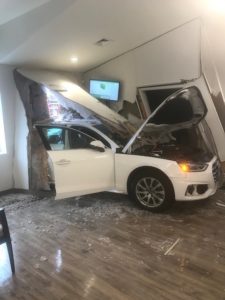WELLFLEET — A white Audi sedan operated by Greta Einig, 74, drove into the Outer Cape Health Services (OCHS) office on Route 6 shortly after 9:30 a.m. on Jan. 18, according to Wellfleet Police Chief Michael Hurley. The car was lodged halfway into the health center’s lobby, just inches away from the glass windows facing the room where approximately half a dozen people were waiting, said Hurley.

There were no serious injuries, Hurley said, and no one was taken to the hospital. Three minor injuries were evaluated at the scene, he said.
“Everybody has been extremely lucky,” OCHS CEO Pat Nadle told the Independent. “It was traumatizing for everybody, but people mobilized. The police, the fire dept., and the building inspector all came out to help. The town has been so responsive.”
The car was dislodged from the building and the scene cleared by 3 p.m. that day.
The incident is currently under investigation, said Chief Hurley; he hopes it will be completed by the end of this week. No charges had been issued as of Jan. 23, and Hurley said it is “more than likely” that Einig will not be charged. “It’s not common that anyone is charged if it is just one person that is involved,” he said.
OCHS Assistant Facilities Manager Kevin Sweeney said that security footage showed the car pulling into the parking lot from Route 6 and then quickly accelerating as it approached a parking space facing the building. He surmised that the accident was caused by a “pedal error.”
Reached at her home in Wellfleet, Einig declined to comment.
OCHS reopened its doors on Friday, Jan. 20, two days after the incident. A temporary wood-framed exterior bearing wall was built pending permits for permanent repairs, said Building Inspector James Badera.
Approximately seven feet of the exterior bearing wall between the waiting room and an unoccupied office was damaged. Eleven feet of interior nonbearing partition was damaged as well, along with parts of the office’s HVAC and electrical systems, Badera said. They have been removed from service until they can be repaired.
According to Badera’s visual observations and the building plans, “the damage did not compromise the overall structural integrity of the building,” he said. This was confirmed at the site by Marshall Puffer of Coastal Engineering, the firm that did the structural engineering design when the building was renovated in 2018.
OCHS Communications Officer Gerry Desautels said that OCHS hopes to complete all repairs off-hours within the next two months.
Desautels also said that OCHS is looking into installing bollards at every parking space facing the building. There are 15 spaces facing the building, but only three spaces reserved for handicapped parking currently have bollards.
100 Crashes Per Day
Hurley said that while incidents like this one are alarming, they are not common. “It’s not a monthly or even a yearly thing,” Hurley said, “but they do happen every once in a while.”
Nationwide statistics paint a different picture. Studies conducted by the Storefront Safety Council (SSC) estimated that there are at least 100 car-into-building crashes each day nationally. That is 36,500 such crashes per year.

According to the SSC, 39 percent of these crashes involve drivers over age 60, and 41 percent are caused by operator error, including pedal error.
But an audit done for Lloyd’s of London by CHC Global, a risk management company, suggested that this estimate may be a lowball. It concluded that SSC may be counting as few as one in every 91 crashes. SSC’s database of 36,000 crashes is compiled from anecdotal and media reports, court records, fire department run records, and published studies, its website says.
“It’s a real public safety concern,” said Rob Reiter, founder of the Storefront Safety Council. “Especially in places like restaurants and health clinics where people usually have their backs to the windows, it can be very hazardous.”
Reiter surmised that health clinics “probably get hit 10 to 15 times a week.”
Fatalities from such crashes, on the other hand, are rare. In 2020, only 210 people died in fatal collisions with buildings, according to a report done by the Insurance Institute for Highway Safety (IIHS). That was 2 percent of all fixed-object crash deaths that year; 46 percent of object-related crash deaths involved collisions with trees, the study found.
Reiter said that the accident at OCHS “sounds like a pedal error,” which is “really quite typical.”
The National Highway Traffic Safety Administration (NHTSA) found that pedal-error accidents occur up to 16,000 times every year in the U.S. The NHTSA also notes that drivers under 20 and over 65 are about four times as likely to be involved in a pedal-confusion accident as other drivers.
Although age may be a factor, Hurley said, it is not a determinant, and the ability to drive past a certain age varies from person to person. Plus, losing one’s license can be an added burden for those who do not live near public transit, he said.
“It’s somebody’s last piece of freedom,” said the chief. “You take somebody’s license away and the options shrink pretty quickly on how to get around. It can become devastating.”
Hurley said that, while the crash at OCHS was unfortunate, the outcome was very fortunate. “We’ve seen other places where this has happened, and there have been people seriously injured or killed,” he said. “It’s just very lucky that nobody was injured.”



